By Jeffrey A. Rendall, Photos By Jeffrey A. Rendall
HAYMARKET, VA -- Standing on the first tee of most golf courses, you can't help but admire what you see. It might be a boldly shaped seaside landscape reminiscent of the old country; or a tightly contoured parkland fairway bordered by yawning sand bunkers and hardwood trees; or a dramatic elevation drop from a red rock cliff to the desert floor below.
Thoughts rush to mind -- "how the heck did they ever put a golf hole here?" and "who ever came up with the idea to do that?" It runs the gamut of emotions from pure envy to perplexed stupefaction. It boils down to one notion -- someone conceived of all this splendor -- had a dream perhaps. Then someone else helped them build it.
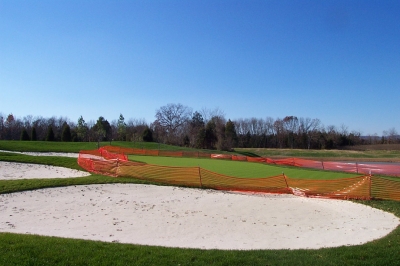 |
But if you only knew how much work -- and creativity -- goes into making a golf course, you'd be doubly impressed when viewing the finished product. Because I'd always been curious about the process, I recently made a trip out to the under-construction Dominion Valley Country Club in Haymarket, to 'walk along' with the folks from Palmer Course Design and DVCC -- to discover for myself what it takes to turn someone's dream into golfing reality.
Dominion Valley's championship course will be the top recreational draw for a new housing development lying at the base of the Bull Run Mountains -- and if its golf course neighbors are any indication, the Palmer inspired track will be pretty special. The Tom Fazio designed Piedmont Golf Club lies directly across Highway 15 from Dominion Valley, and the Rick Jacobsen scribed Bull Run Country Club is just up the road -- two beautiful layouts set amongst the rolling terrain of this once sparsely populated area.
Erik Larsen, Vice President of Palmer Course Design and lead architect on the project, says Dominion Valley provides a great glimpse into the golf course construction process: "The Dominion Valley project is a good one to study if you're seeking to learn about golf course architecture, because it's set on a very varied piece of ground -- but also because it presents all the different phases of construction."
 |
Larsen continues, "We've got a few holes that are completely finished and could literally be played tomorrow. We've got a few that are shaped and just about ready for grassing, a few that are being shaped, and still a few more that have just been cleared. A perfect laboratory for learning about the different phases in design."
I found it fascinating there was so much involved. Larsen says there are three distinct phases. "There's really quite a bit that goes into constructing a golf course, but we'll narrow it down to three stages for our 'teaching' purposes -- the Master Planning stage, the Construction Document stage and finally the Construction Supervision stage."
Master-Planning involves securing the site, viewing topographical maps, obtaining the requisite construction permits, consulting with a civil engineer for proper drainage and mixing in the 'other' parts of the equation, such as housing setbacks, recreational areas, open space and roads.
During this stage, Larsen says it's most efficient to get all the parties together in one room for a 'think tank,' to brainstorm on how the facility might look. Then, using the maps, a rough course routing is selected and centerlines plotted. If everything's in order, it's time to walk the site and set the 54 stakes -- representing tees, greens and directional points.
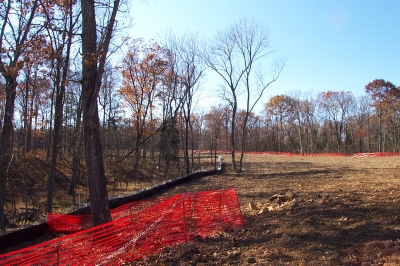 |
Here's also where creativity is a big factor, because it's the best opportunity to work each site's individual strong points into the picture. "That's the fun part, because actually walking the site tells you a lot about the character of the ground, sight lines, interesting topographical features -- the guts of the golf course. Every site is different, and that's what makes each golf course unique," Larsen says.
Molding these rough outlines into a workable construction strategy is stage two, the Construction Documents stage. Larsen says the firm consolidates what's been gathered so far and draws up a set of plans to work from. Construction documents consist of a grading plan, a clearing plan and a set of specifications that verbally describes what the drawings represent.
Despite the complete set of documents, things are hardly set in stone. Larsen adds: "Before we had computers, I sometimes wore out pencil erasers making changes to just one green complex. There's a lot of room to alter things, and that involves continually working with the site, receiving input from the owners, budgetary concerns and even interpretation by the shapers on the project."
It's definitely not an ego thing, either. "We don't want the construction documents to be the absolute final word on something, because we'll get some of the neatest golf hole features just from letting the construction supervisors interpret the drawings and act accordingly. Sure, we'll make regular site visits and correct anything that's clearly wrong, but we'll end up with a much better golf course if we leave some room for folks to use their creativity," Larsen says.
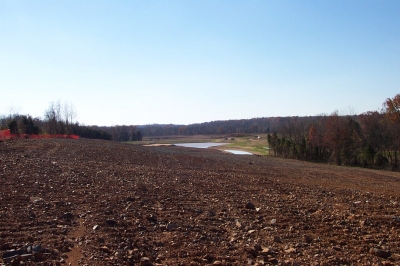 |
Construction Supervision is phase three, and involves keeping a close watch on the progress of the project. At this stage, the contractor's been selected and the dirt's being moved. Larsen says he'll visit sites regularly, not only to make sure things look good, but also to establish a relationship with the client and contractor. "Building a golf course really involves different people playing parts on a large team. Everyone's involved, from Mr. Palmer and the site owners down to the guys driving the bulldozers. We may set up golf courses on paper, but it's all the people on the project who help make it what it is."
I guess you could say a golf course is actually the accumulation of many people's dreams. I like it better that way.
Seeing the process in action was as interesting as learning about it. The group hitting the dirt for the site visit included Larsen, project coordinator Ron Howell and the Dominion Valley group -- Mark Simms, Tom Sayre, John Elcano and course superintendent Mark Waltz, as well as representatives from the construction contractor, Landscapes Unlimited.
We journeyed from hole to hole, where Larsen compared the work being done to his drawings of the hole -- all the while consulting with the various Dominion Valley representatives on different impressions, concerns and visions. Somewhat to my surprise, revisions were actually made on the spot -- it truly was the creative process at work.
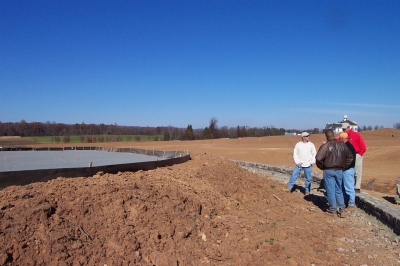 |
One particular debate involved the location of some wetlands in front of a par five's green. Larsen said they didn't work within the context of the hole, and should be taken out. The Dominion Valley group seemed to agree, but would need to clear it with the proper permitting agencies before anything was done -- and Larsen concurred. What may seem like a minor matter of running a dozer over a small section of land actually involves much more.
Larsen said one of the strengths of Dominion Valley's people is their concern for doing things the proper way, and the discussion over this small strip of wetlands demonstrates this: "It's essential when building a golf course--to preserve the natural environment and get things squared away with the proper governing authorities. Things such as preserving wetlands may be seen as a hassle to some, but they're vital to keeping lakes clean and preserving habitat -- which enhances your golf course. There're plenty of ways to make a golf course environmentally friendly, and this particular client recognizes that."
Tom Sayre, Senior Land Development Manager at Dominion Valley, confirms that environmental protection is a high priority: "As we finish each golf hole, we've got a landscape architect working to make sure it fits in well with the surrounding environment. Part of how we've accomplished this is through transplanting trees -- over 2500 so far, which gives the layout a more mature look, while also ensuring our course blends seamlessly with the beautiful natural surroundings."
Dominion Valley CC will also feature quite a bit of water -- Sayre says they've built six lakes on the premises, as well as renovating four others. "We'll have lakes in play on eleven holes and streams come into play on several others. They're certainly there for aesthetic reasons, but also to help with drainage and irrigation -- natural as well as practical supplements to the property."
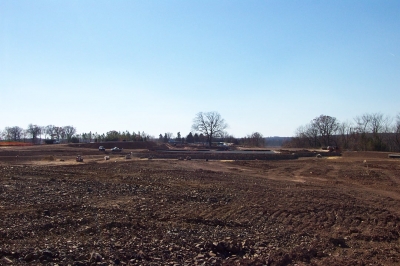 |
We then took a bumpy ride into what will be the back nine -- fresh from being cleared in recent weeks. Here's the phase where imagination takes over -- because it's little different than looking at a tree lined empty lot. At least to me -- whereas I saw only dirt and mud, Larsen sees golf holes.
"After designing courses for over 20 years, I can read the plans and see exactly what the hole will look like. When we're looking over the site, we're essentially checking to make sure the clearing's been done properly, while also searching for more unique site features to possibly incorporate into the design," Larsen says.
Sayre's a golf enthusiast, and says the Palmer group's attention to detail ensures that they'll have something distinctive at Dominion Valley: "What I like best about working with Erik Larsen and the Palmer group is their attention to detail. They make regular site visits, consult with us, and are constantly seeking input. No surprises, and I definitely like what I see out there."
So did I. Unfortunately, we'll have to wait until the spring of 2003 to take our first shots at Dominion Valley Country Club. Until that time, we'll continue to watch the course grow and change -- all the while knowing it started as someone's dream to put a golf course there.
Try and remember that the next time you step up to a first tee.
Details:
Dominion Valley Country Club
14804 Lightner Road
Haymarket, VA 20169
Website: www.dominionvalley.com
Attn: Mark Simms or Tom Sayre
Palmer Course Design Company
Website: www.palmerdesign.com
Erik Larsen -- Vice President, Senior Golf Course Architect and Managing Director
| Related Links | Comments on this article? | |
|
Maryland National Golf Club Hollow Creek Golf Club Rocky Gap Resort PB Dye Golf Club in Ijamsville Whiskey Creek Golf Club |
E-mail Jeff Rendall, Editor: jrendall@golftheunitedstates.com |












